WfC’s focus is on empowering rural communities, especially women and girls, to achieve sustainable development. That means although I am based and work in Lusaka, the impact of every proposal, grant, M&E report, basically anything I write happens somewhere outside the city. It should come as no surprise that when I was offered the opportunity to get out of the city and into the villages where WfC works I leapt at the chance. And so, I found myself spending a little over a week in Choma District, visiting Area Associations, Safe Mother Action Groups, local health clinics, and orphans that WfC has sponsored through school.
My field experience started on a Tuesday afternoon, as I exited the bus saying goodbye to my roommates and praying that Esnart received the text I sent from Leah’s phone- mine had fallen victim to the phone gods the night before, so I lacked all and any form of communication. Thankfully, we managed to meet up and after a quick visit to Spar and the market to purchase everything we would need for the time in the field, we were off!
As we left Choma, the paved roads slowly gave way to gravel than red dirt, the people we saw became fewer and further between each other, and the landscape turned from houses and stores to stretches of dry grasslands as far as the eye could see occasionally dotted with small farms and homes. Finally, three hours later, we arrived at WfC’s Choma District Development Compound.
Since WfC believes in helping people develop their own ability to promote sustainable development a key part of any project is training and skills development. As a result the organization hosts several skills training, sensitizations and leadership development courses in the areas they work in.
A few years ago they realized that rather than paying for those attending to stay in lodges, it’d make a lot more sense to build their own learning compounds which can also double as homes for field animators to stay in and so the Choma District Development Compound became my home away from home (away from home, if you want to get super technical about it all).
We greeted at the compound by a few of the District Development Association members who were anxious to help us get settled. After moving all our gear into the house, we sat down to start interviews. The purpose of our trip was to review an IPAS project focused on improving access to sexual reproductive health rights and also begin collecting data for a Coady project on improving women’s leadership in sustainable livelihood opportunities. In order to do both of those things, it requires a ton of qualitative research, which means a lot of interviews.
This presented a slight challenge. As I had only been in Zambia for a little over a month at the time, my Nyanja was limited to conversations with mini bus drivers- and by conversations I mean I could say I’m going to (niyenda ku), this is my stop (nisala), thank you (zikomo) and I need change (nipasse nichange chonde). (Important Life Lesson: If your mini bus conductor is drunk, always give correct change.). Complicating the matter even further was the fact that Choma doesn’t even use Nynaja as the local language.
Fun fact, there are 74 languages spoken in Zambia. The average Zambian will be able to fluently speak five to seven of them. Makes all the complaining we use to do in high school about having to learn two official languages in Canada seem foolish, doesn’t it?
Thankfully, the district chairperson in Choma- Maggie- had previously hosted a Dutch intern and spoke English well enough to act as my translator; the only condition was that I had to put forth an effort to learn Tonga- Mwabuka buti? Kabotua. Ndime Danielle. Ndazwa ku Canada. Ndilakuyanda ku Choma. Beyond these basic introductions though it seemed any phrase I heard went in one ear and out the other.
Maggie, by the way, is a total all-star.
She’s 53 and so was raised at a time when educating girls was seen as pointless. However, in her adult years, she has taught herself to speak, read and write in English. She has also set up a number of personal businesses to supplement her husband’s income, allowing her to support the family and ensure all females related to her are able to complete their education. Currently, out of Maggie’s 7 children, 3 have completed university, 3 are attending and 2 are still in high school but both plan to attend a post secondary.
So for our week in Choma, Maggie acted as my personal saviour. Beyond translating for me, she also
taught me how to tie a baby to my back (most useful skill ever; somewhere waaaay down the road when I have children I will be using this skill every day), how to cook nshima for 50 (less useful, but I did learn to never mess with a Zambian women because they’re arm strength is out of this world), how to prepare a variety of other delicious Zambian dishes (rape, kapenta, potatoes, cabbage, pumpkin leafs, sardines… yum!) and how to (semi) gracefully exit a truck in a citenge.
Generally, our week in the field was marked with long car rides along bumpy paths to meetings where we would discuss projects, changes and life with people- and naturally there was always some food. It sounds tedious, but in fact it was amazing. The opportunity to speak with people who are actually living out projects you’ve been reading and writing about from the head office is phenomenal. It also helps you realize all the little things that you were never able to clearly see since you don’t have the life experience to fully grasp the complexities.
Over the course of about 100 interviews, there were many stories that came forth.
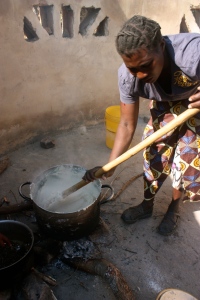
Although gender roles are breaking down, it is still normal to see the women cooking nshima. Like here where we ate this for daaaayssss!
One woman, who happened to be my age, told us how her husband now shared household responsibilities, such as cooking and cleaning which are traditionally seen as women’s roles, after gender sensitizations had shown him he could still be manly even if he admitted to loving her.
Within this story an interesting development question arises; how do you measure something that is qualitative like that? You can’t count love but it’s changed the gender roles of these people’s lives and thus changed their development process, so it’s clearly important to acknowledge, but hard to put in a report.
As WfC is striving towards a society with gender equality a lot of the work is qualitative, but that’s not to say within the information there’s a lack of quantitative information to be found. For example, the IPAS report showed how in the quarter ( a time of three months) since educational sessions were done on the dangers associated with giving birth at home there has been an increase in the average number of births in the local clinics from 3 to 17 per month in one and from 5 to 25 per month in another.
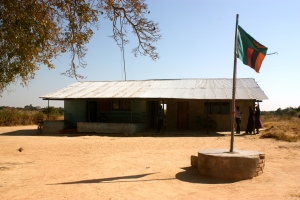
One of the health centres were a WfC SMAG partners. This two room centre serves over 700 people from as far as 70 km away
We were also able to learn from several of the nurses we spoke with about an increase in demands for contraception from young women in the area. The tragic part here is that while girls were learning to ask and use contraception, the supply in the clinics was insufficient to the demand. We actually met two girls, one 16 and one 17, who were both pregnant and they both admitted although they knew of different forms of contraception, none had been available at the clinic so they had simply done without.
Beyond gaining a far better sense of the work WfC does and the challenges inherent in its mission, I was also able to gain a sense of life in rural Zambia. My days started only once the sun rose since there’s no electricity. My morning shower began by heating water over a fire; a fire which was then turned into the cooking fire.
Given the concerns with creatures that go bump in the night and the difficulty of navigating village roads in the dark (potholes that could devour the landrover!), we aimed to be home no later than six every day. Evenings consisted of discussions around the dinner table where everything from the constitutional referendum to a debate over football vs hockey was fair game. Overall, it has definitely been the highlight of my time here and I’m already anxiously looking forward to my next visit to the field.
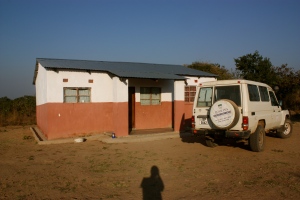
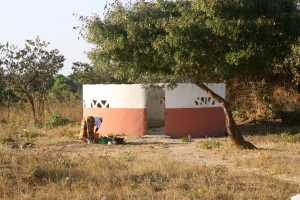
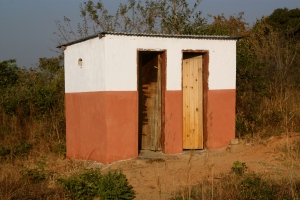
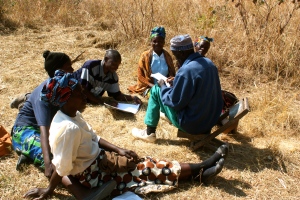
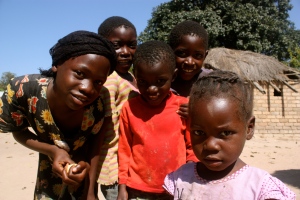
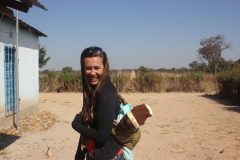
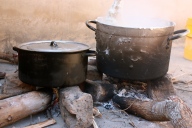
I love hearing your experiences and insights. I imagine the interviews you did were filled with amazing stories that would help you and your project understand people’s needs, strengths and ways of seeing the world.